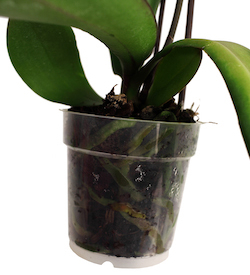
 Potted orchids are quite deceptive. These lush, colorful and elegant plants may look like the typical houseplant, but they’re far from ordinary. In the wild, Phalaenopsis orchids grow on trees, not in the ground. They love humid, tropical climates, soak up moisture from the air and trap airborne plant and animal matter in their roots for food. Because of the high humidity, their roots need good circulation and quick drainage.
Potted orchids are quite deceptive. These lush, colorful and elegant plants may look like the typical houseplant, but they’re far from ordinary. In the wild, Phalaenopsis orchids grow on trees, not in the ground. They love humid, tropical climates, soak up moisture from the air and trap airborne plant and animal matter in their roots for food. Because of the high humidity, their roots need good circulation and quick drainage.
Our three ice cubes per week watering guide is a foolproof way to make sure your tropical beauties stay properly hydrated, but keeping your orchid’s drainage in tip-top shape takes a bit more work. Here are three factors you should consider in order to keep your orchid and its roots healthy:
Take a good look at the “dirt” that your orchid is sitting in. It doesn’t look anything like the typical potting soil you’ve seen, does it? No, this potting media is chunky and contains pieces of bark. Eventually, this potting media will break down, so remember to replace your potting media every 1-2 years in order to keep your orchid’s roots happy for the long-term.
You likely keep your orchid in a pot relative to its size. Smaller orchids do well in smaller pots and larger orchids do well with larger pots. But your plant’s pot size also determines its drainage needs. Larger growing pots require more drainage than smaller pots. On average, pots that are 3-4 inches need 4-8 drainage holes, and pots that are 5-6 inches need 8-12 drainage holes.
The material your grower pot is made out of will also affect your drainage. Clear plastic pots allow you to see the roots through the pot without disturbing the plant. What’s more, because plastic is slick, crucial mineral salts and nutrients from the potting media and fertilizer won’t stick to the pot. This is good because it ensures your orchid, not your pot, is absorbing the mineral salts and nutrients.
Clay pots, on the other hand, are more porous than plastic pots, which may mean your media will dry quickly. Media that dries too quickly can lead to a complete dry out. And with orchids, super dry roots are just as harmful as waterlogged ones. If you keep your orchid in a clay pot, keep your eye on your plant regularly to ensure it’s retaining enough moisture. Also be aware that Phalaenopsis orchid roots like to stick to clay pots, which means you’d have to break the pot or cut the roots in order to remove the plant.
Just Add Ice orchids are always grown and sold in plastic grower pots before being put in a decorative pot. If you prefer the look of clay pots to decorative pots, we recommend keeping your orchid in the plastic grower pot before placing it in the clay pot. This way, you can pull the plant out to examine its roots. You can also empty any extra water from the bottom of your pot, which helps prevent root rot.
Remember, the path to a healthy orchid bloom is through its roots. Use the above information to keep your plant’s roots happy and healthy.
Need help caring for your Phal? Browse our vast video resource library for the best orchid care tips!

Copyright Just Add Ice® Orchids 2023